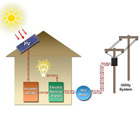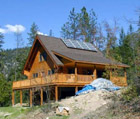

Typical prices for an off grid cottage
Most panels intended for grid tied systems panels have 72 cells or 60 cells. The size of 60 cell panels varies one or 2% by manufacturer. 72 cell panels are larger as a group. Off grid only panels intended for 12V systems have fewer cells, typically 30 cells and are smaller and are much more expensive in terms of $ per Watt.
Off Grid Base Cottage System
This is a base system that can be expanded smoothly to provide extra capacity by adding panels and 2 more 6V batteries in series/parallel. There is a supported configuration for a total of 2, 3, 4 or 6 panels. This system is for a very small electrical load, for very frugal living. It is too small a capacity to recommend it for 4 seasons living or for all year residences. It does use all cUL or CSA approved parts and if installed correctly is capable of meeting the electrical code requirements for safety.
This system delivers a high quality pure sine wave power, that is suitable for computers, TVs and all picky electrical appliances. I started to build this using 30 cell off grid type of solar panels, and then after analysis determined that It could be built with 60 cell panels that are produced in very high volume for grid connected systems for the same price. This reduced the price by a few dollars while more than doubling the panel total wattage. The 640W panel capacity is the minimum size that could provide power to a habitation. This is capable of generating on a sunny day about 8% the capacity of a average modern Ontario grid connected home that uses about 24000W per day. Normally an off-grid house system is designed to run for four days without sun, on a fully charged battery. Therefore this system would deliver about 4% of the daily power used by an average home over a 4 day period.
It stores 4.6 kWh of energy if the batteries are discharged to a maximum of 80%. That is 1.15 kWh per day over a 4 day period.
It uses top of pole ground mounting so that it can be pointed due south.
It uses a prewired panel that encloses all the critical parts and supplies the required circuit breakers, so there are no exposed wires to pose a safety risk and it is much neater in appearance. Only the battery is a separate item.
What is missing?
These prices are for parts only, and do not include installation or shipping.
A good quality generator is essential for long battery life, to recharge the battery after they have become discharged and there is no sun available to provide a charge, due to night time, or an extended period of cloudy days. If batteries are not immediately recharged, they will start to sulphate, which shortens their lifetime. The best generators for off grid use are propane powered, and are designed for unattended automatic starting. The budget gasoline powered generators that you see at the local hardware stores are not recommended, and can't protect the batteries when unattended, since they require manual starting. They could only be used when the building is constantly habitated, and someone is ready to get up in the middle of the night, and start the generator when the battery voltage drops to the minimum permitted value.
An automatic generator start module is not included in the inverter, it is an extra module that can be added (ME-AGS-N Network). This should be ordered if a propane remote start generator is installed.
A fan to ventilate the batteries when they are charging. THis is required for Flooded Lead Acid batteries, but not for sealed AGM or Gel Lead Acid batteries.
A battery enclosure to protect people and pets from the batteries and permit ventilating the battieries to the outside of the building.
The wires from the weatherproof combiner box to the inverter e-panel inputs. These shoud be run inside conduit or poly pipe underground to the edge of the building.
It also does not include items that can be purchased at a hardware store or electrical supplier.
Other Limitations
This only supplies 120V AC, and not 120/240 split phase that is used in hydro connected houses. Therefore only 120VAC appliances can be used. (Some types of submersible water pumps that run on 240V)
Expansion Limits
The Midnight Classic 150 can handle an expansion to up to 6 of the specified solar panels, while the battery voltage remains at 12V. If the battery voltage is changed to 24V, then the charge controller can handle more panels but the Magnun inverter is 12V only and would need to change to switch to 24V which would be a major expense.
The battery can be expanded in capacity by either replacing the batteries or by having a series parallel array of 4 identical batteries.
Caution About Bargain Priced 12V Solar Systems
There are temporary systems that are sold at well know Canadian retailers which seem to cost much less for this amount of power. These are made in China, are not CSA approved, and have the following issues. They do not deliver utility grade sine wave power, (they deliver Modified Sine Wave power) and they can't be expanded to add more panels and batteries, as they have very limited electronics components. They use panels designed to charge 12V batteries. The charge controller won't work with the 230-350W 60 cell panels that are very attractively priced for grid tied systems. They also would not pass an ESA inspection, due to the none CSA approved panels, wiring and electronics. They also don't have any mounting hardware to securely mount the solar panels. They are intended for temporary use at a hunt camp or a tenting trip, not for permanent use.





